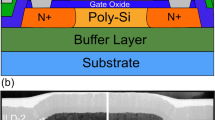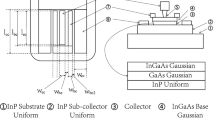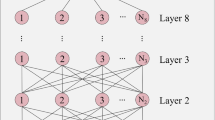Abstract
This work presents a method based on supervised learning for the extraction of parameters in Indium Gallium Zinc Oxide Thin-Film Transistors with aluminium contacts, as an alternative regarding analytical and optimisation methods. The method consists of generating a set of I–V curves of the device of interest using Spice software. These curves are the input samples of the Artificial Neural Networks, from which it is intended to predict the different parameters such as threshold voltage, transconductance and contact resistance, from each sample curve. By generating the training set itself, it is possible to label each sample curve, which allows the type of learning to be supervised. The results show that ANNs provide parameters with which it is possible to model physical measurements with error rates of less than 5% when extracting the first two parameters, and errors of between 0.06% and 4.62%, when extracting the three parameters. In addition, a comparison was made between the results of the ANNs and the analytical extraction of parameters.










Similar content being viewed by others
Data availability
The datasets generated during the current study are available from corresponding author.
References
S. Raczynski, Modeling and simulation, 1st edn. (Wiley, Hoboken, 2014), pp.1–14
H. Khan, M. A. Bazaz, S. A. Nahvi, Simulation Acceleration of High-Fidelity Nonlinear Power Electronic Circuits Using Model Order Reduction, in: 5th IFAC Conference on Advances in Control and Optimization of Dynamical Systems (2018) https://doi.org/10.1016/j.ifacol.2018.05.069
P. Moreno, R. Picos, M. Roca, E. Garcia, B. Iniguez, M. Estrada, Parameter extraction method using genetic algorithms for an improved OTFT compact model. Spanish Conf. Electron Devices (2007). https://doi.org/10.1109/SCED.2007.383996
C. Tanaka, K. Ikeda, Comprehensive investigation on parameter extraction methodology for short channel amorphous-InGaZnO thin-film transistors, in: 2018 IEEE International Conference on Microelectronic Test Structures (IEEE, 2018) doi: https://doi.org/10.1109/ICMTS.2018.8383756
A. Ortiz-Conde, F.J. García-Sánchez, J. Muci, A. Terán Barrios, J.J. Liou, C.-S. Ho, Microelectron. Reliab. (2013). https://doi.org/10.1016/j.microrel.2012.09.015
A. Cerdeira, M. Estrada, R. García, A. Ortiz, F.J. García, Solid State Electron (2001). https://doi.org/10.1016/S0038-1101(01)00143-5
S.K. Ojha, B. Kumar, SILICON (2022). https://doi.org/10.1007/s12633-021-01149-6
C. Avila, A. Ortiz, J.A. Caraveo, M.A. Quevedo, Trans. Electr. Electron. Mater. 22(4), 550–556 (2021). https://doi.org/10.1007/s42341-020-00268-y
P. Mittal, Y.S. Negi, R.K. Singh, J. Comput. Electron (2015). https://doi.org/10.1007/s10825-015-0719-8
K. Bhargava, V. Singh, J. Comput. Electron (2014). https://doi.org/10.1007/s10825-014-0574-z
S. Xin-zhi, L. Hai-wen, S. Xiao-wei, C. Yan-feng, C. Zhi-qun, L. Zheng-fan, Wuhan Univ. J. Nat. Sci. (2005). https://doi.org/10.1007/BF02830676
S. Nautiyal, P. Mittal, Contact resistance in organic transistors: Extraction using variable length method, in: 2017 International Conference on Computing, Communication and Automation, (IEEE, 2017) doi: https://doi.org/10.1109/CCAA.2017.8230051
M.E. Rivas-Aguilar et al., Curr. Appl. Phys. (2018). https://doi.org/10.1016/j.cap.2018.04.002
A. Pacheco-Sanchez, M. Claus, S. Mothes, M. Schröter, Solid State Electron. (2016). https://doi.org/10.1016/j.sse.2016.07.011
H. Bae et al., IEEE Electron Device Lett. (2016). https://doi.org/10.1109/LED.2015.2509473
N. Akkan, M. Altun, H. Sedef, Parameter Extraction Method Using Hybrid Artificial Bee Colony Algorithm for an OFET Compact Model, in: 2018 15th International Conference on Synthesis, Modeling, Analysis and Simulation Methods and Applications to Circuit Design (IEEE, 2018) doi: https://doi.org/10.1109/SMACD.2018.8434861
S. Moparthi, P. K. Tiwari, G. K. Saramekala, Genetic algorithm-based threshold voltage prediction of SOI JLT using multi-variable nonlinear regression, in: 2021 International Symposium on Devices, Circuits and Systems (IEEE, 2021) doi: https://doi.org/10.1109/ISDCS52006.2021.9397911
S. I. Sayed, M. M. Abutaleb, Z. B. Nossair, Improved CNFET performance based on genetic algorithm parameters optimization, in: 2017 8th IEEE Annual Information Technology, Electronics and Mobile Communication Conference (IEEE, 2017) doi: https://doi.org/10.1109/IEMCON.2017.8117185
I. Benacer, Z. Dibi, Int. J. Autom. Comput. (2016). https://doi.org/10.1007/s11633-015-0918-6
R. Picos et al., Solid. State. Electron. (2007). https://doi.org/10.1016/j.sse.2007.02.031
J. Oh et al., ECS J. Solid State Sci. (2022). https://doi.org/10.1149/2162-8777/ac6894
Q. Yao et al., Micromachines (2021). https://doi.org/10.3390/mi13010004
Berkeley, Aim-Spice, (Software, 2022), http://www.aimspice.com/. Accessed 08 August 2022
R.J. Baker, CMOS, 3rd edn. (Wiley-IEEE Press, Hoboken, 2010), pp.131–145
M. Flasiński, Introduction to artificial intelligence, 1st edn. (Springer, Cham, 2016), pp.156–157. https://doi.org/10.1007/978-3-319-40022-8
P. Isasi, I. Galván, Redes neuronales artificiales (Pearson Prentice Hall, Madrid, 2004), pp.1–60
M. Hagan, H. Demuth, M. Beale, O. De Jesus, Neural network design, 2nd edn. (Ebook, Nedlands, 2014), p.2.2-2.10
W. Ertel, Introduction to artificial intelligence, 2nd edn. (Springer, Cham, 2017), pp.245–260. https://doi.org/10.1007/978-3-319-58487-4
Analog Devices Inc., LTspice, (Software, 2022), https://www.analog.com/en/design-center/design-tools-and-calculators/ltspice-simulator.html. Accesses 09 August 2022
ScikitLearn, sklearn.model_selection.GridSearchCV, (Website, 2022), https://scikit-learn.org/stable/modules/generated/sklearn.model_selection.GridSearchCV.html#sklearn.model_selection.GridSearchCV. Accessed 09 August 2022
Google, Colaboratory, (Website, 2022), https://research.google.com/colaboratory/intl/es/faq.html. Accessed 09 August 2022
M. Abadabi et al., Tensorflow, (Website, 2022), https://www.tensorflow.org/?hl=es-419 Accessed 09 August 2022
Acknowledgements
Nanoscience, Micro and Nanotechnologies Centre of the National Polytechnic Institute is thanked for the fabrication of devices whose transferential curves were used to test the methodology proposed in this research. Thanks, are also due to the National Council of Science and Technology for the scholarship for advanced studies.
Funding
The authors have not disclosed any funding.
Author information
Authors and Affiliations
Contributions
RCV performed the parameter extraction using NNs and drafted the manuscript, NHC manufactured the transistors with which the method proposed in this work was tested, RZG performed the parameter extraction using the analytical method, FGL and ALC analysed the proposed method and improved the form and wording of the manuscript.
Corresponding author
Ethics declarations
Conflict of interest
The authors declare that they have no conflict of interest.
Additional information
Publisher's Note
Springer Nature remains neutral with regard to jurisdictional claims in published maps and institutional affiliations.
Rights and permissions
Springer Nature or its licensor (e.g. a society or other partner) holds exclusive rights to this article under a publishing agreement with the author(s) or other rightsholder(s); author self-archiving of the accepted manuscript version of this article is solely governed by the terms of such publishing agreement and applicable law.
About this article
Cite this article
Valdés, R.C., García, F., García, R.Z. et al. Parameter extraction in thin film transistors using artificial neural networks. J Mater Sci: Mater Electron 34, 555 (2023). https://doi.org/10.1007/s10854-023-09953-z
Received:
Accepted:
Published:
DOI: https://doi.org/10.1007/s10854-023-09953-z




